Monarch
(Reign) | Badges [7] [8] | Examples |
|---|
 House of Plantagenet House of Plantagenet 
(1154–1399) |
|---|

Henry II
(1154–1189) | | 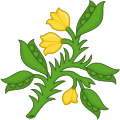 |
|---|

Richard I
(1189–1199) | | 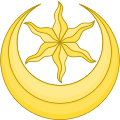  |
|---|
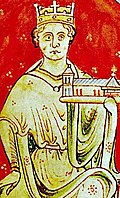
John
(1199–1216) | - a golden star and crescent
- a sprig of broom
|   |
|---|

Henry III
(1216–1272) | |  |
|---|
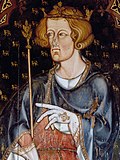
Edward I
(1272–1307) | - a golden rose, the stalk green
- a sprig of broom
|   |
|---|

Edward II
(1307–1327) | |  |
|---|
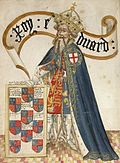
Edward III
(1327–1377) | |      |
|---|

Richard II
(1377–1399) | - a Sunburst
- a Hart Argent lodged, ducally gorged and chained Or (from his mother; Joan of Kent)
- a Stock (stump) of a tree eradicated and couped Or (from his father; Edward of Woodstock; or the Black Prince)
- a Falcon Argent
- a Sprig of broom, Planta genista, the cods open and empty
- a Sun in splendour
- an Ostrich feather
- the Sun clouded
| 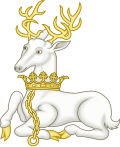  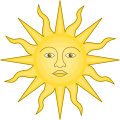  |
|---|
 House of Lancaster House of Lancaster 
(1399–1461) |
|---|

Henry IV
(1399–1413) | | 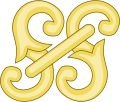     |
|---|

Henry V
(1413–1422) | - an Ostrich feather Argent
- an Ostrich feather erect Argent with a small scroll across the lower part of the quill inscribed "Ich dien"
- an Antelope, chained
- a Swan, chained
- a Fire beacon or cresset
- a Stock of a tree
- the Red rose of Lancaster
- a Fox's tail
- a Trunk of a tree eradiated Or (for the Dukedom of Hereford) [12]
- a Swan, wings elevated Argent, beaked and legged Gules, ducally gorged and a chain reflexed over the back Or (of Hereford) [13]
- a Swan and antelope lodged, both chained to the fire-beacon and conjoined into one device [14]
|     |
|---|
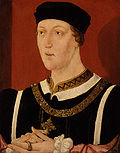
Henry VI
(1422–1461) | - an Antelope, chained
- a Swan, chained
- a Spotted panther
- two Ostrich feathers in saltire, Or and Argent
- the Red rose of Lancaster
|     |
|---|
 House of York House of York 
(1461–1485) |
|---|

Edward IV
(1461–1483) | |   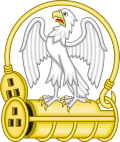   |
|---|
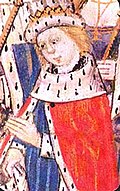
Edward V
(1483) | - a Falcon Argent, in a fetterlock of gold
- a Rose Argent
|   |
|---|

Richard III
(1483–1485) | - a Boar Argent, armed and bristled Or
- the White rose of York
- a Sun in splendour
- a White falcon with a virgin's face holding a white rose
|     |
|---|
 House of Tudor House of Tudor 
(1485–1603) |
|---|

Henry VII
(1485–1509) | |   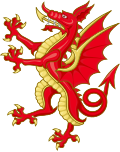   |
|---|

Henry VIII
(1509–1547) | - a Fleur-de-lis Or
- a Red dragon
- a Greyhound Argent, collared Gules
- a Silver cock with red comb and wattles
- Flames of fire
- a Dun cow of Warwick
- a Harp Or, stringed silver, crowned (For Ireland)
- a Portcullis Or, crowned; as used with motto Altera securitas
- the Tudor rose
- a Rose Gules, dimidiated with a pomegranate (for his first wife; Catherine of Aragon; the pomegranate is the symbol of Granada in the royal arms of the Kingdoms of Castile and Aragon)
- a Demi-rose Gules, impaled with a demi-roundel parted palewise Argent and Vert, charged with a bundle of arrows Argent, garnished Or (also for his first wife)
|      |
|---|

Edward VI
(1547–1553) | - a Fleur-de-lis Or
- a Red dragon
- a Greyhound Argent, collared Gules
- a Harp Or, stringed silver, crowned
- a Portcullis Or, crowned
- the Tudor rose
- a Rose Gules, crowned
- a Sun in splendour
|  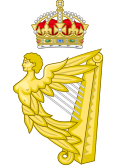   |
|---|

Mary I
(1553–1558) | - a Pomegranate (for her mother; Catherine of Aragon)
- a Pomegranate and rose conjoined (also used by her mother personally)
- a Rose Gules within a white one, impaled with a demi-roundel parted palewise Vert and Azure, charged with a bundle of arrows Argent, ensigned with a crown, surrounded by rays Or
- a Winged Time drawing Truth from a Pit, with the inscription "Veritas temporis filia" [18]
- an Altar, thereon a sword erect, with the words "Arae et Regne Custodia" [18]
- the Tudor rose
- a Harp Or, stringed silver, crowned
- a Portcullis Or, crowned
- a Fleur-de-lis Or
| 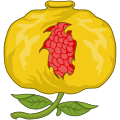   |
|---|
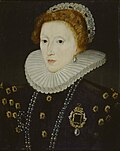
Elizabeth I
(1558–1603) | - a Falcon Argent, crowned and holding a sceptre Or (for her mother; Anne Boleyn)
- a Tudor rose, crowned with the motto "Rose sine Spina"
- a Sieve
- a Phoenix
- a Harp Or, stringed silver, crowned
- a Portcullis Or, crowned
- a Fleur-de-lis Or
| 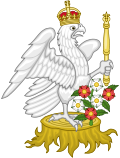    |
|---|
 House of Stuart House of Stuart 
(1603–1649) |
|---|

James I
(1603–1625) | - the Tudor rose; Rose Gules, with a rose Argent superimposed, crowned (for England)
- a Thistle, slipped and headed Proper, royally crowned (for Scotland and the House of Stuart) [19]
- a Fleur-de-lis Or, crowned (for France)
- a Rose Gules, with a rose Argent superimposed, dimidated with a thistle in its Proper colours, crowned (for the Union of the Crowns)
- a Harp Or, stringed silver, crowned (for Ireland)
|   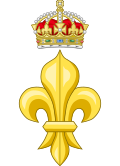   |
|---|

Charles I
(1625–1649) | - the Tudor rose; Rose Gules, with a rose Argent superimposed, crowned (for England)
- a Thistle, slipped and headed Proper, royally crowned (for Scotland)
- a Fleur-de-lis Or, crowned (for France)
- a Rose Gules, with a rose Argent superimposed, dimidated with a thistle in its Proper colours, crowned (for the Union of the Crowns)
- a Harp Or, stringed silver, crowned (for Ireland)
|      |
|---|
 Interregnum Interregnum 
(1649–1660) |
|---|
 House of Stuart (Restored) House of Stuart (Restored) 
(1660–1707) |
|---|

Charles II
(1660–1685) | - the Tudor rose; Rose Gules, with a rose Argent superimposed, crowned (for England)
- a Thistle, slipped and headed Proper, royally crowned (for Scotland)
- a Fleur-de-lis Or, crowned (for France)
- a Rose Gules, with a rose Argent superimposed, dimidated with a thistle in its Proper colours, crowned (for the Union of the Crowns)
- a Harp Or, stringed silver, crowned (for Ireland)
|      |
|---|
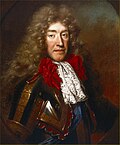
James II
(1685–1688) | - the Tudor rose; Rose Gules, with a rose Argent superimposed, crowned (for England)
- a Thistle, slipped and headed Proper, royally crowned (for Scotland)
- a Fleur-de-lis Or, crowned (for France)
- a Rose Gules, with a rose Argent superimposed, dimidated with a thistle in its Proper colours, crowned (for the Union of the Crowns)
- a Harp Or, stringed silver, crowned (for Ireland)
|      |
|---|

William III and Mary II
(1689–1694) | - the Tudor rose; Rose Gules, with a rose Argent superimposed, crowned (for England)
- a Thistle, slipped and headed Proper, royally crowned (for Scotland)
- a Fleur-de-lis Or, crowned (for France)
- a Rose Gules, with a rose Argent superimposed, dimidated with a thistle in its Proper colours, crowned (for the Union of the Crowns)
- a Harp Or, stringed silver, crowned (for Ireland)
|      |
|---|

William III
(1689–1702) | - the Tudor rose; Rose Gules, with a rose Argent superimposed, crowned (for England)
- a Thistle, slipped and headed Proper, royally crowned (for Scotland)
- a Fleur-de-lis Or, crowned (for France)
- a Rose Gules, with a rose Argent superimposed, dimidated with a thistle in its Proper colours, crowned (for the Union of the Crowns)
- a Harp Or, stringed silver, crowned (for Ireland)
|      |
|---|

Anne
(1702–1707) | - the Tudor rose; Rose Gules, with a rose Argent superimposed, crowned (for England)
- a Thistle, slipped and headed Proper, royally crowned (for Scotland)
- a Fleur-de-lis Or, crowned (for France)
- a Rose Gules, with a rose Argent superimposed, a thistle in its Proper colours, growing from the same stalk, crowned (for Great Britain, after the Acts of Union)
- a Harp Or, stringed silver, crowned (for Ireland)
|    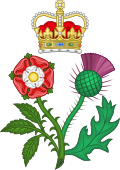  |
|---|
|















































































